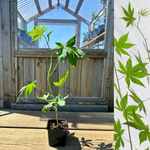Subscribe and save 10%!

'Sweetleaf®' / Sweetleaf 30-50 cm (Rubus chingii var. suavissimus)
295 SEK
Unit price perExpected delivery date: 21 December to 28 December.
Applies to orders within Sweden. For other countries - see our delivery terms .
In stock - Ready to be shipped
Share
295 SEK
Unit price per1st plant 'Sweetleaf®': current height 30-50 cm
Common name: 'Sweetleaf®' Raspberry, Sweetleaf, 'Sweetleaf®' Raspberry, Sugarleaf
Scientific name:
Rubus chingii var. suavissimus
Family: Rosaceae
Plant history & use:
Sweetleaf® is a raspberry species originating from China, where it grows mainly in the southern provinces of Guizhou, Guang Dong and Guangxi. The shrub is relatively unknown but is becoming highly sought after due to its sweetening ability and hardy qualities.
Sweetleaf® can be described as a more hardy alternative to Stevia: as its leaves contain so-called 'rubusosides' which are part of the same glycoside group as steviosides, and as it is fully winter-hardy and even has a vigorous growth habit.
The two glycosides stevioside and rubusoside are very similar in their chemical structure and therefore have a nearly identical sweetening effect. The chemical molecule 'rubusoside' in its pure form is approximately 200 times sweeter than commercially refined sugar from sugar beets in its pure form.
Even fresh leaves have an enormous sweetness. If you chew on a leaf, it tastes quite neutrally "green" at first, before a distinctive, broad, dull sweetness takes over the taste buds.
Sweetleaf ® has no odd aftertaste, which stevia is often criticized for.
To use Sweetleaf®: tear or cut the freshly harvested leaves into pieces and then blanch them in boiling water. In the process, the sweetening substances are released from the leaves and absorbed by the water. The amount of leaves used is purely a matter of taste. Some like it a little sweeter (more leaves); others don't like it quite so sweet (fewer leaves). You can also rub the leaves in your palms before blanching them, so the leaf structure breaks down and the sweeteners can more easily escape from the cells.
The leaves can also be used as a sweetener in dried form, powdered or by boiling a syrup with them.
Great for sweetening teas and pastries.
Rubus chingii var. suavissimus is one of four species used in Guangxi, China to make the ethnomedicine tiancha (sweet tea).
Culture:
Sweetleaf® is a vigorous, deciduous shrub. The fast-growing shoots have enormous vigor with an upright growth habit and reach a final height of approximately 250 cm. Due to the strong growth force, the fresh shoots are very tolerant of pruning and grow back quickly.
The fresh, green shoots are heavily armed with thorns, but this is not of major importance as only the leaves are of interest. The leaves have a striking, five-lobed shape.
Best grown in well-drained soil in sunny to semi-shade. location. Generally tolerant of many different soils.
Features:
Year: Perennial
Growing conditions: sun - partial shade
Height: 1.5-2.5 m
Growing zone: 1-4
- Choosing a selection results in a full page refresh.
- Opens in a new window.



